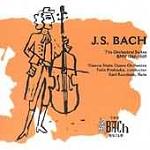It’s impossible today to listen to repertoire masterworks without filing–even unwillingly–through one’s mental catalogue of competing recordings and interpretations. Even the most cursory glance at excellent options for these four suites reveals a wealth of choices: Savall perhaps, or Kuijken, or Klemperer. But maybe even more important than surveying this cornucopia of selections is understanding how the past few decades have transformed the general listening experience when it comes to Baroque music. Even among casual listeners, knowledge of Bach’s music–what we sense structurally and artistically in his compositions, and what we anticipate in performances of his works–is inevitably filtered through the lens of the “historically informed performance” revolution. Whether or not you care for the early music movement’s aesthetic sensibilities, this generation of musicians has profoundly altered our basis for hearing and understanding Bach.
Felix Prohaska’s 1952 interpretation on this Vanguard Classics reissue certainly is a testament to a very nascent interest in historically informed performance practice; at the time of first release, this set was trumpeted as the first to “realize the graces and ornaments which abound in these works according to the performance practice of Bach’s own time.” (This recording was based on a new edition prepared by Prohaska, then-Vanguard music director Seymour Solomon, and a Dutch musicologist by the name of Gustav Leonhardt.)
Some listeners will gravitate toward the unquestionable plushness of the Viennese players’ sound and will appreciate the obvious gravitas with which they approach these cornerstone works. (The one exception is Karl Reznicek’s thoroughly sprightly and charming flute solo in the second suite’s Badinerie movement.) But Prohaska’s foursquare, unremittingly even rhythmic pacing most likely will bore listeners, especially those who have nursed on more recent recordings. The sound is fine, but that probably will not be of much concern either to listeners who are otherwise unconvinced of these performances’ musical value or even to those who pick up the CD for nostalgia’s sake.
































